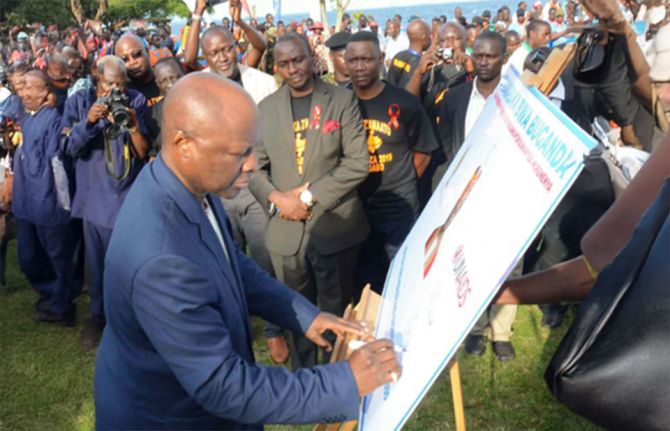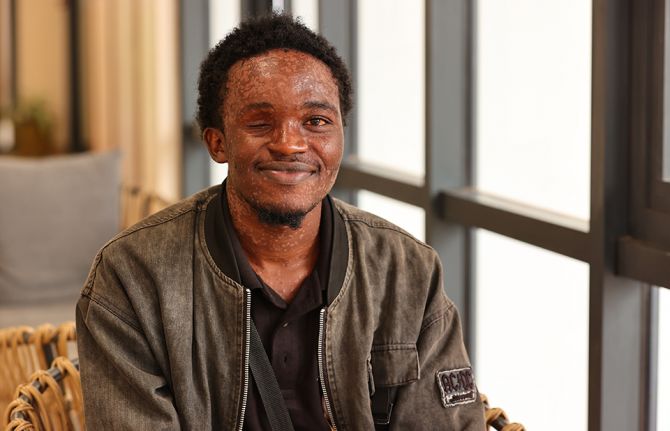
Feature Story
Food security response to HIV and gender-base violence in northern Uganda
07 October 2010
07 October 2010 07 October 2010
Credit: UNAIDS
The fertile northern region of Uganda was known for many years as one of the granaries of the country, consistently producing surpluses for local and international food markets. But two decades of civil conflict between the Uganda People’s Defense Forces (UPDF) and the Lord’s Resistance Army (LRA) have left the Acholi and Lango sub-regions destitute.
Between 1986 and 2006 an estimated 1.8 million people fled from their villages to the shelter of temporary camps. In Kitgum, Gulu, Pader and Amuru districts an estimated 95% of the population lived in such camps.
The war caused significant setbacks in education, healthcare, food production and infrastructure. It also increased vulnerability, particularly amongst girls and women, as well as gaps in HIV service provision to the internally displaced persons (IDPs).
"They have lost almost everything, their assets, their livelihoods. They have lost their skills. You know, they were used to farming and staying in the camps meant that a whole generation lost out on those skills”, says Winifred Nalyongo, a livelihoods specialist with the United Nations Food and Agriculture Organisation (FAO).
In 2006, internally displaced persons began returning to or near their places of origins following the singing of a Cessation of Hostilities Agreement between the Government of Uganda and the LRA. The UN refugee agency (UNHCR) estimated that more than 70 per cent of all internally displaced persons had returned home or in transition camps in January 2009.
HIV and gender-based violence in early recovery settings
It is in this early recovery setting that FAO has been working to re-establish the livelihoods of the communities impacted by the conflict through the Farmer Field and Life Schools (FFLS) and Junior Farmer Field and Life Schools (JFFLS) programmes. These involve a group learning process whereby women and men farmers learn valuable agricultural and life skills that allow them to improve their livelihoods and reduce their vulnerability to food insecurity, HIV and gender-based violence, among others.
Conflict and displacement are known to be factors in heightening exposure to HIV. In the Northern Ugandan IDP camps, alcoholism and sexual violence are widespread. FAO representatives indicate that forced in a situation of idleness and unable to feed their families men may become frustrated and turn to alcohol, thus exacerbating existing gender inequalities, making women and children more vulnerable to HIV.

Credit: UNAIDS
The UNAIDS/UNHCR policy brief on HIV and refugees mentions that, as refugees struggle to meet their basic needs such as food, water and shelter, women and girls are often forced to exchange sexual services for money, food or protection. Children living without parental support, whether due to separation from or death of family members, are also particularly vulnerable to sexual and physical violence and exploitation.
A 2005 UNICEF study in one of Northern Uganda’s largest IDP camps found that six out of ten women were physically and sexually assaulted by men.
According to a 2004-2005 Ministry of Health survey, HIV prevalence in the war-affected areas of Northern Uganda is at 8.3% compared to the national average of 6.4%.
Reducing vulnerability
FAO’s Farmer Field and Life Schools place strong emphasis on food security and self-reliance as a means to reduce vulnerability to HIV and gender-based violence. They emphasize farming as a business, encouraging members to generate money from their crops, but also teach valuable life skills such as gender sensitivity, child protection, hygiene, nutrition and HIV awareness.
People living with HIV are encouraged to join the FFLS where they receive nutrition training, an important component in HIV positive living. They can also learn how to farm less labour intensive crops such as okra or vegetable gardens.
Learning new skills early on
In Dubaju village, FAO’s Junior Farmer Field and Life Schools help orphans and vulnerable children to become more self-sufficient and improve their food security. They also learn about staying healthy and protecting themselves from HIV through classroom-based discussions. For example, children learn how to protect crops from pests or treat diseased crops and draw parallels with how they can take care of their bodies and prevent themselves from becoming infected with HIV.



